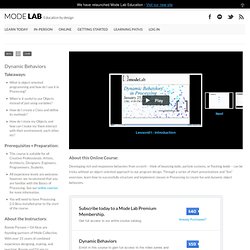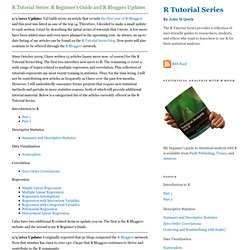

Designers: Learn To Code! Here's How To Start. A friend, formerly a competitive fighter, once asked me: "Have you ever been punched in the face?

" He and I were about to get in a bar fight. He needed to know if I could handle myself: Apparently, the fear of getting punched in the face holds you back from being effective in a fight. But once you’ve been punched in the face, you realize it’s not so bad—it’s easy to fling yourself into a fight without hesitating. Similarly, learning how to code can be intimidating if you’ve never done it before. But whatever you don’t know is bound to hold you back from learning. The first punch I want you to download Processing.
If you want to just download the code, it’s here. Once you get it typed out, hit the play button and see what cool stuff you just made with the code. Playing around is fun, but how does this all relate back to your work? When you start playing with these tools and you understand how they work, you’ll start adding these things into what I call your "mental toolbox. " Dynamic Behaviors. Takeaways: What is object-oriented programming and how do I use it in Processing?

When is it useful to use Objects instead of just using variables? How do I create a Class and define its methods? Fun Programming - Circular motion: sine and her cousin. Fun Programming. 1.0 _ALPHA_ - Tutorial: Simple Motion - Simple OOP. Krzywe Beziera. W kolejnej lekcji języka programowania Processing (poprzednia jest tutaj), zajmiemy się krzywymi Beziera.

Dlaczego ? Ponieważ krzywe te są bardzo często podstawowym środkiem definiowania nie-liniowej geometrii np. fasad lub dachów. Nie są one co prawda tak popularne jak krzywe B-Spline (chociaż są ich najprostszą wersją), lub ich rozszerzona wersja – NURBS, ale od nich wszystko się zaczęło, więc warto przyjrzeć się im z bliska (są na przykład używane w programie Adobe Illustrator). Na początek omówimy podstawy tworzenia krzywych, i kilka technicznych elementów pomocnych w kreowaniu trójwymiarowych struktur w Processing. Potem stworzymy program rysujący powierzchnię dachu (jak powyżej) i eksportujący ją do pliku. Spróbujmy napisać kilka lini kodu rysujących przykładową krzywą Beziera. Zdefiniujmy zatem łańcuch współrzędnych: cztery współrzędne X (łańcuch będzie miał nazwę ‘px’), i cztery współrzędne Y (łańcuch o nazwie ‘py’) float px [] = new float[4]; float py [] = new float[4];
Processing tutorial: Drawing Arcs. Processing tutorial: Interacting with zooming, rotating, and sliding. 09 - Processing 101 - Circular Paths. Processing Tutorials – Plethora Project. Plethora-Project.com is an initiative to accelerate computational literacy in the frame of architecture and design.

It aligns with the "show me your screens" motto of the TopLap live-coding group attempting to get rid of Obscurantism in digital design. Directed by Jose Sanchez Contact me at : jomasan@gmail.com Bio: Jose Sanchez is an Architect / Programmer / Game Designer based in Los Angeles, California. He is partner at Bloom Games, start-up built upon the BLOOM project, winner of the WONDER SERIES hosted by the City of London for the London 2012 Olympics.
He is the director of the Plethora Project (www.plethora-project.com), a research and learning project investing in the future of on-line open-source knowledge. Plethora Project. Processing. Processing Tutorial 07 - Classes. Kurs Processingu. R Tutorial Series: R Beginner's Guide and R Bloggers Updates. 1/1/2011 Update: Tal Galili wrote an article that revisits the first year of R-Bloggers and this post was listed as one of the top 14.

Therefore, I decided to make a small update to each section. I start by describing the initial series of tutorials that I wrote. A few more have been added since and even more planned in the upcoming year. As always, an up to date listing of my articles can be found on the R Tutorial Series blog. New posts will also continue to be offered through the R Bloggers network. Since October 2009, I have written 13 articles [many more now, of course] for the R Tutorial Series blog. Introduction to R Descriptive Statistics Summary and Descriptive Statistics Data Visualization Scatterplots Correlation. Processing, JSON & The New York Times. Processing is my tool of choice for building visualizations for a number of reasons.

First, it’s easy to start projects, quick to piece together code and simple to share the results – it’s an ideal rapid-prototyping tool. Second, the wide variety of libraries available mean that it’s easy to plug into data in various formats and process the data into an easily-usable form. Finally, output from Processing sketches can be exported as .TIFFs, .JPGs, .PNGs, .PDFs, .MOVs and more, making the end project easy to deploy. I was reminded of all of these advantages last week when I sat down to build some simple visualizations from the newly-opened New York Times APIs. Within a few hours I was up and running – and within a few more hours I had some results that I was quite happy with. Here is the link to the source for my New York Times visualization tool: NYTimes.zip (168k)
Working with Processing & Google Spreadsheets on Datavisualization. Visualizing text.
Learn programming 55: How many items in an Array? Processing Questions and Answers.